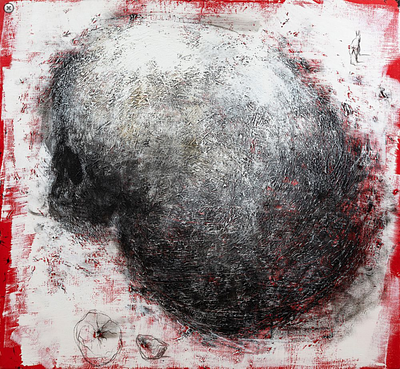LUCIO MUÑOZ (Madrid, 1929 - 1998). "Sketch, 1966. Mixed media on wood. Signed and titled on the back. Size: 21 x 30 cm; 43 x 52 cm (frame).
Lot 71
About Seller
Setdart Auction House
Carrer Aragó 346
Barcelona
Spain
Setdart Subastas was born in 2004 and is currently the first online art auction in Spain with solidity, prestige and reliability guaranteed by our more than 60,000 users. Setdart has a young, dynamic and enterprising team ready to successfully manage the purchase and sale of art works through custom...Read more
Categories
Estimate:
EUR€7,000 - EUR€8,000
$7,291.67 - $8,333.33
Absentee vs Live bid
Two ways to bid:
- Leave a max absentee bid and the platform will bid on your behalf up to your maximum bid during the live auction.
- Bid live during the auction and your bids will be submitted real-time to the auctioneer.
Bid Increments
| Price | Bid Increment |
|---|---|
| EUR€0 | EUR€10 |
| EUR€200 | EUR€25 |
| EUR€500 | EUR€50 |
| EUR€1,000 | EUR€100 |
| EUR€3,000 | EUR€200 |
| EUR€5,000 | EUR€500 |
| EUR€10,000 | EUR€1,000 |
| EUR€20,000 | EUR€2,000 |
| EUR€50,000 | EUR€5,000 |
About Auction
By Setdart Auction House
Oct 19, 2021
Set Reminder
2021-10-19 08:00:00
2021-10-19 08:00:00
America/New_York
Bidsquare
Bidsquare : CONTEMPORARY ART
https://www.bidsquare.com/auctions/setdart-auction-house/contemporary-art-7701
Setdart Auction House sofia@setdart.com
Setdart Auction House sofia@setdart.com
- Lot Description
LUCIO MUÑOZ (Madrid, 1929 - 1998). "Sketch, 1966. Mixed media on wood. Signed and titled on the back. Size: 21 x 30 cm; 43 x 52 cm (frame). During the 1960s, Lucio Muñoz consolidated his career as an artist, laying the foundations of his personal style. This work belongs to a period in which Muñoz began to work with wood, interested in its qualities and in all that it could contribute to a pictorial composition. In this particular work, different textures can be appreciated, as well as a mastery of the material, in which he creates a kind of trompe l'oeil between volume and flatness. The result of placing a strip of wood as a table in this syntactic still life. One of the foremost exponents of Spanish Informalism and a pioneer of abstraction in the country, Lucio Muñoz began his career focusing on landscape painting, one of the most cultivated genres in Spain at the time, largely thanks to the influence of Benjamín Palencia. He began his training at the San Fernando Academy of Fine Arts, where he was a pupil of Eduardo Chicharro. After completing his studies he came into contact with the Madrid realists Antonio López and the López Hernández brothers. He made his individual debut in 1955, with an exhibition at the Dintel gallery in Santander consisting of works already close to abstraction, which reveal the influences of Klee, Rufino Tamayo, Ben Nicholson and Torres García. That same year he takes part in a collective exhibition organised by the Dirección General de Bellas Artes, together with Antonio López, Julio L. Hernández and Francisco López. The following year he obtained a grant from the French State to complete his training in Paris. There he studied the works of Fautrier, Dubuffet, Wols and Tàpies, and his style drifted definitively towards Informalism, leaving behind the initial influences of Cubism and Expressionism. From this point onwards Muñoz became fully committed to Abstract Expressionism. He returned to Spain and held two exhibitions that tell us about the establishment of his personal style and place him squarely in the Spanish avant-garde. The first took place at the Fernando Fe gallery in Madrid in 1957, and the second was held the following year at the Ateneo in the same city. His material painting, his original, sensitive and personal use of materials, gives his compositions a poetic and lyrical dimension. The importance Muñoz attaches to the support itself stands out in his production; the artist perforates, tears, makes incisions, etc., approaching Informalism in a totally personal way. His works, most of which are colourful, represent the purest informalism. After an initial stage of experimentation with the most diverse materials (burnt paper, wood, etc.), in his final phase his painting became less aggressive, due to the use of materials with less relief and a palette tending towards monochrome. During these years his influences broadened to include the black paintings of Goya, the work of Velázquez, Gregorian chant with its solemn depth, the sober and infinite landscapes of Castile, the liberated energy of flamenco and the engravings of Albrecht Dürer. In 1961 he held his first solo exhibition abroad at the Joachim Gallery in Chicago, and two years later he exhibited for the first time in New York at the Staemplfi Gallery. Since then he has had solo exhibitions all over Spain, as well as in cities such as Buenos Aires, Frankfurt, Lisbon, Munich, London, Havana, Paris, Berlin and Brussels. From the late sixties onwards Muñoz gradually began his most fantastic and nocturnal period, a trend that would continue until 1981. The exhibition held that year at the Juana Mordó gallery heralded the change towards a flatter, lighter language, such as that found in the series of large-format colour engravings the artist produced between 1983 and 1984.
- Shipping Info
-
In-house shipping available. Please inquire at admin@setdart.com.
-
- Buyer's Premium



 EUR
EUR CAD
CAD AUD
AUD GBP
GBP MXN
MXN HKD
HKD CNY
CNY MYR
MYR SEK
SEK SGD
SGD CHF
CHF THB
THB

















